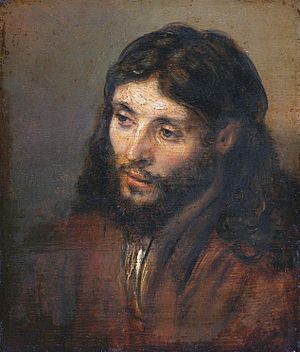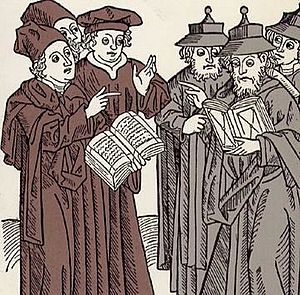Jesus in the Talmud facts for kids
The Talmud is a very important collection of Jewish writings that includes teachings, laws, and stories. Some people believe that certain parts of the Talmud talk about Jesus. The name used in these parts is "Yeshu". This name is a version of the Hebrew name Yeshua.
It's tricky to say for sure if these "Yeshu" mentions are about Jesus. This is because some of the people named Yeshu in the Talmud lived at different times than Jesus. For example, one Yeshu was said to be executed by a government that lost power in 63 BC. Another Yeshu was a student around 74 BC. And a third Yeshu's stepfather talked with a rabbi around 134 AD. These dates are much earlier or later than when Jesus lived, which makes it hard to connect them.
The Talmud has faced changes over time. The first time Christian leaders tried to remove parts of the Talmud was in 521 AD. Later, during the Middle Ages, the Catholic Church accused the Talmud of saying bad things about Jesus and his mother, Mary. Jewish people replied that these parts were not about Jesus, but about other people named Joshua (a common name). Because of these disagreements, many references were removed from later versions of the Talmud.
Today, scholars have different ideas about whether the Talmud talks about Jesus. Some scholars, called "minimalists," think very few parts refer to Jesus. Others, called "maximalists," believe many parts do. These "maximalists" often think the stories are not historical facts about Jesus, but rather Jewish stories that reacted to or made fun of Christian beliefs.
Some older versions of the Talmud are missing these references because they were removed by Christian censors or by Jewish people themselves who were afraid of punishment. However, most modern versions of the Talmud published since the early 1900s have put these references back in.
Contents
History of Discussions About Jesus in the Talmud
During the Middle Ages, the Catholic Church held many public debates about Judaism. In these debates, some Jewish people who had converted to Christianity claimed that the Talmud contained insults about Jesus.
One of the first books to talk about Jesus in the Talmud was Pugio Fidei (meaning "Dagger of Faith") around 1280. Later, in 1681, a book called Flaming Arrows of Satan was published, which also discussed Jesus in the Talmud. The first book completely about this topic was Jesus in Talmude in 1699. Another book, Judaism Unmasked, published in 1700, also talked about Jesus in the Talmud. Sadly, this book was later used to create a lot of anti-Jewish writings.
In the 1900s, people started to study this topic in a more fair and academic way. Scholars wrote books trying to understand the Jewish writings about Jesus. Some scholars thought many references were about Jesus, but not as a real historical person. Others found little to no evidence of a historical Jesus in the Talmud. Some concluded that the evidence was small and mostly legendary, reflecting how Jewish people tried to respond to Christian ideas.
More recently, in 2007, a scholar named Peter Schäfer tried to find a middle ground. He believed that references to Jesus were added to the Talmud in the 3rd and 4th centuries. He thought these stories were like parodies (funny imitations) of the stories about Jesus found in the New Testament.
Different Views on Jesus in the Talmud
In the first few centuries AD, there were many different groups within Judaism. Some scholars think that early Christianity was just one of these groups. These groups often wrote things that supported their own beliefs and sometimes criticized rival groups. Some experts see the descriptions of Jesus in the Talmud as part of these rivalries. This means the stories could be seen as criticisms by the rabbis (Jewish teachers) who wrote the Talmud, aimed at Christianity as it grew.
How it Relates to the New Testament
Scholar Peter Schäfer believes that the parts of the Talmud talking about Jesus were written later, around the 3rd and 4th centuries. He thinks these parts in the Babylonian Talmud were "counter-stories" that made fun of the New Testament stories, especially about Jesus' birth and death. He suggests that the rabbis who wrote them knew about the Christian Gospels. Schäfer argues that the Talmud's message was a strong statement that Judaism was correct. It showed that they felt no shame for punishing someone they saw as a blasphemer (someone who insulted God) and idolater (someone who worshipped idols).
The New Testament itself also shows disagreements with Jewish leaders of the time. For example, in the Bible, there are verses where people accuse Jesus of having a demon. In return, the Bible also describes some Jewish groups in a negative way.
Early Jewish Thoughts on Christianity
Some scholars, like Daniel J. Lasker, suggest that the Talmud stories about Jesus were not meant to be direct attacks. Instead, they were early signs of Jewish disagreements with Christianity. These disagreements later grew into stronger criticisms.
A Mixed Relationship
Jeffrey Rubenstein believes that some stories in the Talmud show a mixed relationship between rabbis and Christians. He suggests that some Jewish people thought Christians were good healers, but rabbis saw this belief as a big problem. These stories also show that there was more contact between Christians and Jews in the 2nd century than many people thought.
Debates and Censorship
Between 1239 and 1775, the Catholic Church sometimes forced parts of the Talmud to be removed or destroyed because they disagreed with them.
During the Middle Ages, there were several public debates about Judaism led by Catholic leaders. In these debates, Jewish people who had converted to Christianity claimed that the Talmud contained insulting references to Jesus.
Jewish leaders defended the Talmud in different ways. For example, in 1240, Yechiel of Paris argued that one passage about a person named Yeshu in the Talmud was not about the Christian Jesus. However, he admitted that another reference to Yeshu might be. This idea of "two Jesuses" was used in later Jewish defenses.
Even today, some Jewish experts do not believe that the Talmud's stories about Jesus' death refer to the Jesus of the New Testament. Some scholars also think that the name Yeshu was a real, though rare, name used at the time.
Many times between 1239 and 1775, all copies of the Talmud were destroyed. After the printing press was invented, the Pope banned the Talmud. All printed versions of the Talmud were censored. In 1559, the Talmud was completely banned. Later, a version with removed parts was allowed. But in 1592, the Pope ordered all copies, even the changed ones, to be destroyed. This complete ban lasted until 1775. As a result of these debates, many old handwritten copies of the Talmud had references to Jesus removed or changed. Few original copies survived.
In the 1900s, new editions of the Talmud started to put the censored material back in.
Changes to the Text Over Time
Starting in the 1200s, handwritten copies of the Talmud were sometimes changed because of criticisms from the Christian church. Existing copies were sometimes erased, and new copies often left out certain parts entirely. This means that different versions of the Talmud can have slightly different texts, especially in the parts that were once debated. For example, some versions might mention "Jesus the Nazarene" while others might have the name erased or replaced with "the sinners of Israel."
Does the Talmud Help Us Learn About the Historical Jesus?
Some scholars, like Bart Ehrman, say that the references to Jesus in the Talmud are from much later times (hundreds of years after Jesus lived). They believe these references don't give us reliable information about what Jesus taught or did during his life.
Peter Schäfer agrees that the stories about Jesus' execution in the Talmud are about Jesus of Nazareth. However, he also thinks these Jewish writings are from a later period and might have used information from the Christian Gospels, possibly as a way to respond to them.
Scholars still debate whether the Talmud gives us any real evidence about Jesus as a historical person.
- Some scholars, like Johann Maier, think that the Talmud offers almost no evidence for the historical Jesus. They believe that mentions of Jesus' name were added later. They point out that some stories in the Talmud have dates that don't match when Jesus lived.
- On the other hand, scholars like Joseph Klausner believe that the Talmud does give some insights into Jesus as a historical person. They argue that the Talmud is important because it shows the "other side's view" of Jesus. These scholars have used the Talmud to learn more about the historical Jesus.
Connection to the Toledot Yeshu
The Toledot Yeshu (meaning "History of Jesus") is a Jewish writing that tells a story about Jesus. It's an early account of Jesus based on Jewish views, describing him as the son of Joseph. Some scholars think that this work is just a longer version of the anti-Christian ideas found in the Talmud. However, other scholars believe that the Toledot Yeshu was written later, in the Middle Ages, so it probably didn't come before the Talmud.
See also
- Historicity of Jesus
- Judaism and Christianity
- Judaism's view of Jesus
- Yeshu
- Yeshua (name)



